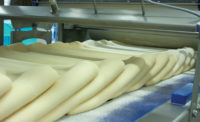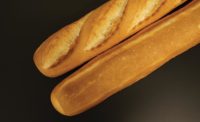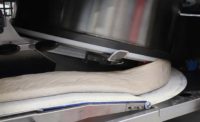Laminators and sheeters continue as essential components of many bakery operations, thanks to several prevailing consumer trends.
“The No. 1 trend driving the market for sheeting and laminating lines is the increasing market for artisanal, high-quality products ranging from rolls to ciabatta to baguettes,” says Rich Breeswine, general manager, Koenig Bakery Systems, Ashland, VA.
Koenig’s latest addition to its sheeting and laminating lines—the Menes 1.0 line—enables bakers to produce a range of fancy pastry and breads, including loaf bread, baguettes, ciabatta, donuts, croissants and flatbreads like pitas. The line features the “TwinSat” principle, a twin satellite head that keeps mechanical loads on dough to a minimum and largely restricts dough tension.
David Moline, sales and marketing manager, Moline Machinery LLC, Duluth, MN, also cites the continued popularity of flatbreads and artisan breads as a reason why bakers are investing in sheeters. “Sheeting systems allow bakers to move quickly into trendy products by utilizing multiple dough formers, allowing for enough sheeting capacity and cutting system versatility,” he says.
The company’s Libra dough sheeter line offers a wide variety of models that allow bakers to produce anything from tortillas to ciabatta, says Moline. Where space is a concern, the Libra triple sheeter provides three pair of reduction rollers for maximum sheeting capability in a small footprint. The Libra Galaxy sheeter provides no-stress reduction via multi-roll heads that maintain cell structure formed during mixing, which is essential for high-hydration doughs like ciabatta. The line also features single and dual sheeters.
“Overall demand for Mexican food and tortillas, specifically, has taken tortillas from a niche market to the mainstream,” says Kyle Armstrong, sales manager, J.C. Ford Co., La Habra, CA. “This has put more pressure on producers to grow their production and invest in higher-capacity systems with greater automation.”
Armstrong says the same holds true for the snack food market. “There’s also been a trend and increased demand for tortilla chips that include other ingredients besides just corn,” he says. “The demand for chips that include ingredients such as kale, rice, various whole grains and other ‘good-for-you’ ingredients has also been on the rise. These products often have stiff or sticky dough and require a more heavy-duty platform to deal with them, which is what the 1600 series sheeter was built for.”
Now available in a 62-inch-wide version, J.C. Ford’s 1600 series sheeter allows for eight rows of corn tortillas and 16 rows of tortilla chips, resulting in up to 10,000 dozen corn tortillas per hour and 4,000 pounds of tortilla chips per hour. The sheeter is also equipped with the company’s latest automatic thickness control (ATC) system, which automatically monitors and adjusts the roller gap to maintain precise product thickness and weight with little to no operator interaction (for a video of the sheeter in action, see “J.C. Ford Corn Tortilla Automation” at www.snackandbakery.com/videos).
Producer concerns
The ability to create healthier versions of popular baked goods and snacks is a key factor prompting bakers and snack producers to invest in laminators and sheeters.
“The clean-label trend has many of our clients eliminating ingredient additives that, in the past, made machining easier or made the product withstand the punishing effects of some equipment types,” explains Eric W. Riggle, vice president, Rademaker USA Inc., Hudson, OH. “The elimination of these additives means we are seeing more and more low-stress and gentle dough-processing methods being used, like the Rademaker DSS (double-chunking sheeting system) and LSS (low-stress sheeter) systems.”
This is also a premium-product proposition. Riggle suggests that higher-quality products—versus lower-cost, lower-margin products—benefit from a gentle dough process, as well as in-line and automated fermentation and retarding systems.
Rademaker has recently focused on creating a very low-stress sheet of dough via its DSS system. “This ultra-low-stress sheeter allows our customers to increase the hydration of their bakery products to even higher levels, such as with soft, artisan bread products,” says Riggle. “Also, pre-fermented doughs gain extra benefit due to the DSS not having a degassing effect, so the quality and product integrity are protected. The DSS is ideal for croissant and artisan bread production.”
Since bakers and snack manufacturers usually produce an assortment of goods, they typically want processing equipment, including laminators, that’s versatile and can handle multiple products.
“We manufacture process lines on which multiple products can be manufactured,” says Donald Smith, engineering sales and service, Thomas L. Green, Reading Bakery Systems, Robesonia, PA. “This requires our process lines to be designed to allow bakers to either produce a laminated product or a nonlaminated product.”
Introduced approximately five years ago, the Thomas L. Green fully servo-motor-controlled dough laminator offers more-consistent dough sheet cutting and laminating than previous models using a combination of servo motors and variable-frequency drives, according to Smith. “Our laminators are designed to laminate any combination of dough layers between three and 10 laminations,” he says.
As consumer demand for flaky pastries, artisan breads, crispy crackers and other baked goods and snacks continues to grow as manufacturers continue to find ways to perfect these products.









